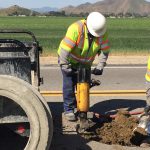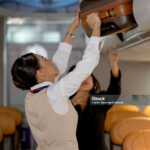 Manufacturing and distributions environments require meticulous attention to safety protocols and ergonomic practices to maintain productivity and worker well-being. Our Toolbox Talks address:
Manufacturing and distributions environments require meticulous attention to safety protocols and ergonomic practices to maintain productivity and worker well-being. Our Toolbox Talks address:
- Machine Guarding: Ensuring proper use of machine guards and other safety measures to protect workers from mechanical hazards.
- Ergonomic Workstation Design: Guidelines for setting up workstations to reduce repetitive strain injuries and increase productivity.
- Material Handling Safety: Procedures for handling, storing, and disposing of materials that are either heavy, hazardous, or cumbersome.
- Noise Exposure: Measures to mitigate the risks associated with prolonged expose to high noise levels.
 Worker safety and safe driving practices are crucial due to the inherent risks associated with prolonged driving, handling packages, and working under time constraints. Our Toolbox Talks for professionals in this sector focus on:
Worker safety and safe driving practices are crucial due to the inherent risks associated with prolonged driving, handling packages, and working under time constraints. Our Toolbox Talks for professionals in this sector focus on:
- Ergonomic Driving Posture: Tips for adjusting seats, steering wheels, and mirrors to maintain good posture, reduce strain, and prevent other points of fatigue from arising during long hours of driving.
- Package Handling and Lifting Techniques: Proper methods for lifting and carrying packages to minimizing the risk of back injuries and other points of concern, ensuring that drivers handle goods safety and efficiently.
- Safe Loading and Unloading: Techniques for safely loading and unloading delivery vehicles to prevent injuries and ensure goods are securely transported without damage.
 In healthcare settings, the focus on ergonomics and safety is critical for both patients and staff. Our Toolbox Talks include:
In healthcare settings, the focus on ergonomics and safety is critical for both patients and staff. Our Toolbox Talks include:
- Safe Patient Handling: Techniques for lifting and moving patients to prevent injuring to both patients and healthcare providers.
- Workplace Management: Ensuring that the tools and equipment available are used to their full potential to reduce the likelihood for fatigue and injury to occur while working for long periods of time.
- Preventative Actions: Utilizing stretching before and after a long day, as swell as recommending doctor recommended equipment, to ensure that the risk of developing aches and pains while on the job are reduced.
 In laboratories, maintaining safety and ergonomic standards is critical due to the complex tasks and potential exposure to hazardous materials. Our Toolbox Talks for lab professionals focuses on:
In laboratories, maintaining safety and ergonomic standards is critical due to the complex tasks and potential exposure to hazardous materials. Our Toolbox Talks for lab professionals focuses on:
- Material Handling and Safety: Comprehensive guidelines for safely handling, storing, and disposing of chemicals, including the use of personal protective equipment and proper handling of other hazardous or dangerous material.
- Ergonomic Workstation Design: Tips for setting up laboratory workstations to reduce repetitive strain injuries, including proper arrangement of equipment, use of ergonomic chairs and stools, and Implementation of adjustable work surfaces.
- Proper Use of Laboratory Equipment: Instructions on the correct use and maintenance of laboratory equipment, such as microscopes and pipettes, ensuring both accuracy and safety.
 In office environments, promoting safety and ergonomic best practices is essential to ensure employee well-being and productivity. Our Toolbox Talks for office workers focus on:
In office environments, promoting safety and ergonomic best practices is essential to ensure employee well-being and productivity. Our Toolbox Talks for office workers focus on:
- Ergonomic Seating: Tips for selecting and adjusting office chairs to support good posture, reduce back pain, and prevent other points of discomfort. This includes proper seat height, lumbar support, and armrest positioning.
- Computer Ergonomics: Guidelines for setting up computer workstations to minimize eye strain, neck pain, and repetitive strain injuries. Recommendations include correct monitor height, keyboard and mouse placement, and screen distance.
- Workstation Organization: Tips for maintaining an organized and clutter-free workstation to enhance efficiency and reduce stress.
 In the construction industry, ensuring safety and ergonomic practices is vital due to the high-risk nature of the work environment. Our Toolbox Talks for construction sites focus on:
In the construction industry, ensuring safety and ergonomic practices is vital due to the high-risk nature of the work environment. Our Toolbox Talks for construction sites focus on:
- Fall Prevention: Comprehensive strategies to minimize fall hazards, including proper use of equipment such as ladders and harnesses.
- Manual Material Handling: Techniques for lifting, carrying, and transporting materials safely to avoid muscle and joint paints. This includes proper body mechanics and the use of mechanical aids when necessary.
- Site Safety Inspections: Procedures for conducting regular safety inspections to identify and mitigate potential hazards. This includes checking for proper signage, secure barriers around dangerous areas, and ensuring all workers have access to proper equipment and training.
 The hospitality industry demands a focus on both worker and guest safety. Our Toolbox Talks cover:
The hospitality industry demands a focus on both worker and guest safety. Our Toolbox Talks cover:
- Slip, Trip and Fall Prevention: Methods to reduce the risk of slips, rips and falls while on the job.
- Safe Cleaning Practices: How to use proper equipment and cleaning chemicals to reduce the risk of injury or illness.
- General Housekeeping Ergonomics: Techniques to reduce strain and injury risk while performing general tasks for housekeeping staff.
 In the aviation industry, safety and ergonomics are critical due to the physically demanding tasks and dynamic work environment. Our Toolbox Talks for baggage handling and flight crew professionals focus on:
In the aviation industry, safety and ergonomics are critical due to the physically demanding tasks and dynamic work environment. Our Toolbox Talks for baggage handling and flight crew professionals focus on:
- Safe Lifting Techniques: Best practices for lifting and transporting baggage to prevent injuries. This includes using proper body mechanics, lifting aids, and team lifting strategies for heavy and awkward items.
- Baggage Handling Equipment: Guidelines for the correct use and maintenance of baggage handling equipment such as conveyor belts, baggage carts, and tugs to ensure operational safety and efficiency.
- Flight Crew Safety: Strategies to combat fatigue and strain for flight crew members while they perform their daily tasks and cater to passengers.
Welcome to our “Toolbox Talks” resource hub, where we share our extensive experience in enhancing workplace safety and ergonomics across a variety of industries.
We have collaborated with professionals in a multitude of fields, allowing us to hit on topics such as preventing heat stress, safe lifting techniques, proper material handling, maintaining appropriate work posture, and optimizing workspaces. Each talk is crafted to provide actionable insights, helping to foster a safer, more efficient working environment.
Explore our comprehensive collection of Toolbox Talks to find industry-specific guidance and best practices aimed at improving the health and safety of your workforce.
All our services can be hand-tailored to your company’s needs. To request a quote, or if you are interested in learning more about how our services can help you run a safe and ergonomic work environment, please follow the link below to get in contact with one of our skilled ergonomic professionals.